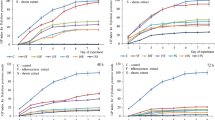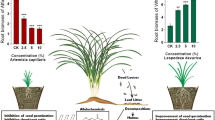Summary
The aqueous extract of Euphorbia granulata Forssk., prepared in Hoagland's nutrient solution; and underlying soil significantly inhibited germination and radicle growth of Dichanthium annulatum, Cynodon dactylon, Setaria italica, Pennisetum americanum, Euphorbia pilulifera, Oxalis corniculata and Lactuca sativa invariably in laboratory bioassays. Artificially decomposed E. granulata litter in a nutrient medium significantly reduced germination and fresh and dry weight of the aforementioned test species. The toxins affected germination and growth independently. The local dominance of this weed over its counterparts was primarily due to allelopathy, and it is therefore suggested that its litter must be removed from the fields during weeding.
Similar content being viewed by others
References
Akhtar, N., Naqvi, H.H., Hussain, F.: Biochemical inhibition (Allelopathy) exhibited by Cenchrus ciliaris L. and Chrysopogon aucheri (Bioss.). Stapf. Pak. J. Forst. 28, 194–200 (1978)
Anjum, G.: The biochemical ecology of common weeds of wheat crop in Peshawar district. M. Sc. Thesis. Univ. Peshawar (1974)
Segum, I.: Allelopathic effects of Panicum antidotale Retz. M. Sc. Thesis. Univ. Peshawar (1978)
Bell, D., Muller, C.H.: Dominance of California annual grassland by Brassica nigra. Am. Midl. Nat., 90, 277–299 (1973)
Bokhari U.G.: Allelopathy among prairie grasses and its possible ecological significance. Ann. Bot. (London) 42, 127–136 (1978)
Cox, G.W.: Laboratory manual of general ecology. Dübüque, Iowa: Wm. C. Brown Co. 1967
Dirvi, G.A.: Germination and allelopathic studies on Dichanthium annulatum (Forssk) Stapf. and Hyparrhenia rufa (Ness) Stapf. M. Sc. Thesis. Univ. Peshawar (1977)
Dirvi, G.A., Hussain, F.: Allelopathic effects of Dichanthium annulatum (Forssk) Stapf. on some cultivated plants. Pak. J. Sci. Ind. Res. 22, (in press 1979)
Friedman, J., Orshan, G.: Allelopathic distribution of two varieties of Medicago laciniata (L.) Mill. in the Negev desert. J. Ecol., 62, 107–114 (1974)
Gadoon, M.A.: Allelopathic effects of Sorghum vulgare and Setaria italica. M. Sc. Thesis. Univ. Peshawar. (1977)
Guenzi, W.D., McCalla, T.M.: Phytotoxic substances extracted from soil. Soil. Sci. Soc. Am. Proc. 30, 214–216 (1966a)
Guenzi, W.D., McCalla, T.M.: Phenolic acids in oats, wheat, sorghum and corn residues and their phytotoxicity. Agron. J. 58, 303–304 (1966b)
Guenzi, W.D., McCalla, T.M., Norstadt, F.A.: Presence and persistance of phytotoxic substances in wheat, oat, corn and sorghum residues. Agron. J. 59, 163–165 (1967)
Hussain, F., Qureshi, H.A., Begum, I.: Allelopathic effects of tobacco (Nicotiana rustica L.) litter on maize (Zea mays L.) and mustard (Brassica campestris L.). Pak. Tobacco 3, 17–20 (1979)
Lodhi M.A.K.: Soil plant phytotoxicity and its possible significance in patterning of herbaceous vegetation in bottom land forest. Am. J. Bot. 62, 618–622 (1975)
Lodhi, M.A.K.: Allelopathic effects of decaying litter of dominant trees and their associated soil in a low land forest community. Am. J. Bot. 65, 340–344 (1978)
McCalla, T.M.: Studies on phytotoxic substances from microorganisms and crop residues at Lincoln, Nebraska. In: Biochemical interaction among plants, pp. 39–43. Washington, D.C.: US Nat. Acad. Sci. (1971)
Muller, C.H.: Allelopathy as a factor in ecological process. Vegetatio 18, 348–357 (1969)
Muller, C.H.: Phytotoxins as a plant habitat variables. Recent adv. Phytochem. 3, 105–121 (1970)
Naqvi H.H., Muller, C.H.: Biochemical inhibition (Allelopathy) exhibited by Italian Rye-grass (Lolium multiflorum L.). Pak. J. Bot. 7, 139–147 (1975)
Naqvi, H.H.: Some phytotoxic compounds in Italian Rye-grass Pak. J. Bot. 8, 63–68 (1976)
Qureshi, H.A.: Allelopathic potentiality of Columbus grass [Sorghum almum (Piper) Parodi]. M. Sc. Thesis. Univ. Peshawar (1978)
Tinnin, R.O., Muller, C.H.: The allelopathic influence of Avena fatua: the allelopathic mechanism. Bull. Torrey Bot. Club 99, 287–292 (1972)
Tukey, H.B., Jr.: Implication of allelopathy in agricultural sciences. Bot. Rev. 35, 1–16 (1969)
Wang, T.S.C., Yang, T.K., Chang, T.T.: Soil phenolic acids as plant growth inhibitors. Soil Sci. 103, 239–246 (1967)
Author information
Authors and Affiliations
Rights and permissions
About this article
Cite this article
Hussain, F. Allelopathic effects of Pakistani weeds: Euphorbia granulata Forssk. Oecologia 45, 267–269 (1980). https://doi.org/10.1007/BF00346468
Received:
Issue Date:
DOI: https://doi.org/10.1007/BF00346468




